Update!
Okaloosa Darters removed from
Endangered Species List in July 2023!
See final rule by USFWS here.
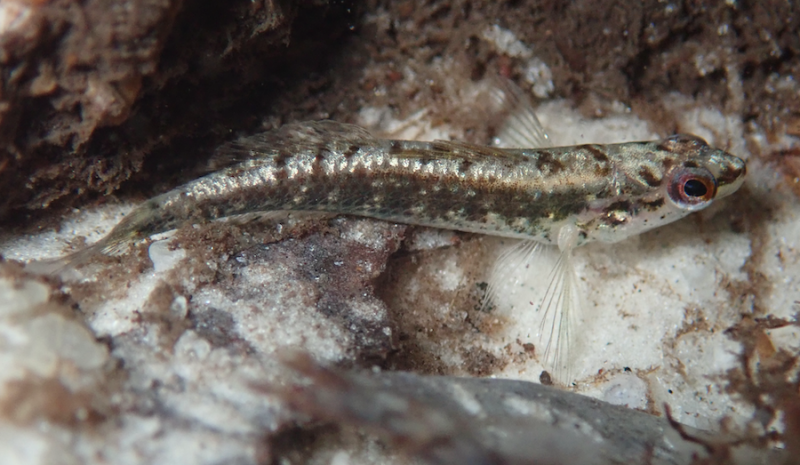
This page highlights research conducted by Professor Frank Jordan in collaboration with Howard Jelks of the US Geological Survey (USGS), Bill Tate of the US Fish & Wildlife Service (USFWS), Dan Holt of Columbus State University, dozens of students from Loyola University New Orleans, and numerous volunteers. Financial support for this research was provided primarily by the United States Air Force and the research could not have been conducted without the logistical support of the Jackson Guard Natural Resources Office of Eglin AFB. Frank Jordan and Howard Jelks owe a debt of gratitude to Noel Burkhead and Jim Williams for inviting us many eons ago to initiate ecological studies of Okaloosa Darters and for working so hard to ensure the long-term conservation success of this species. Please contact Frank Jordan if you need additional information.

General – the Okaloosa Darter (Etheostoma okaloosae) is a small-sized fish in the Family Percidae. Like most other darters in the genus Etheostoma, Okaloosa Darters lack swim bladders and live on the bottom of streams where they feed on the aquatic larvae of stoneflies, mayflies, caddisflies, and non-biting midges. Okaloosa Darters are typically found along the margins of clear, sandy bottomed streams in association with root mats, snags of leaves and other organic debris, submerged aquatic plants, and other forms of cover. Their most likely predators include sunfishes, Largemouth Bass (Micropterus salmoides), and a couple of species of pickerel. More information about the life history of Okaloosa Darters may be found in a USFWS finding here, a recovery plan here, and a short publication from the Endangered Species Bulletin here. Note that these documents are largely based on data collected in the studies described below.
Why Okaloosa Darters were added to the Endangered Species List – this species was one of the first to be added to the List when the Endangered Species Act was enacted in 1973 because of limited geographic range, interspecific competition with a second species of darter, Brown Darters (Etheostoma edwini), that were thought to be introduced, small population size (<2,000 individuals), and habitat loss and alteration associated with extensive erosion across the sandy landscape of Eglin AFB. Okaloosa Darters don’t appear to be keystone species, but they are very sensitive to changes in their habitat and therefore serve as indicator taxa for the ecological health and well-being of the small streams where they live.
Microhabitat use – one of our first studies focused on quantifying habitat use of Okaloosa Darters and their putative competitors, Brown Darters. This study involved setting up 20-meter study reaches at several dozen locations, visually locating darters, marking the location of individual adults and juveniles of both species of darters, and then returning to each marker to collect detailed information on microhabitat features such as water depth, stream flow, substrate type, and canopy type. We also collected similar information from transects in each stream reach. This study is where we discovered that we could fairly easily find Okaloosa Darters while snorkeling and that visual surveys could be used to survey abundance and distribution of Okaloosa Darters. We also learned that Okaloosa Darters preferred the margins of streams where water flow was reduced and abundant forms of cover were readily available. Okaloosa Darters generally avoid large expanses of open sand found in the middle portions of their streams. One of our first student colleagues – Melissa Kaintz – studied microhabitat use of the co-occurring Blackbanded Darter (Percina nigrofasciata) as part of her honors thesis.
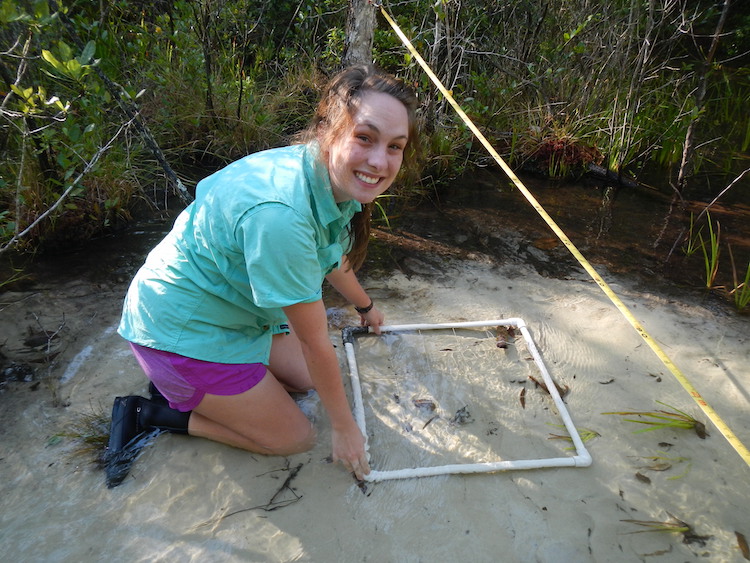
Competition with Brown Darters – during our study of microhabitat use, we noticed considerable overlap in habitat use between the two species of darters. Adult Brown Darters tended to be more associated with beds of flocculent organic matter that accumulate along stream margins with sluggish stream flow, although this is also where very young Okaloosa Darters tended to reside. Overlap in resource use is a red flag when evaluating the presence of competition between species. Howard Jelks tediously compiled historical collection records of Okaloosa and Brown darters into a geochronological database and we discovered that 1) Brown Darters were present in many of the earliest collections of Okaloosa Darters and that 2) some other fish species had similar patterns of limited co-occurrence with Okaloosa Darters in the Rocky Creek drainage. Further, our long-term monitoring indicated that both species coexist over long periods of time in some locations with only subtle shifts in their relative abundance. Finally, we collaborated with geneticist Jim Austin of the University of Florida and found that Brown Darters in our study streams are genetically similar to populations in the nearest streams outside of the range of Okaloosa Darters. Collectively, these data indicate that Brown Darters are native to Rocky Creek drainage and appear to coexist with Okaloosa Darters in what Noel Burkhead termed a zone of “fluctuating sympatry.”
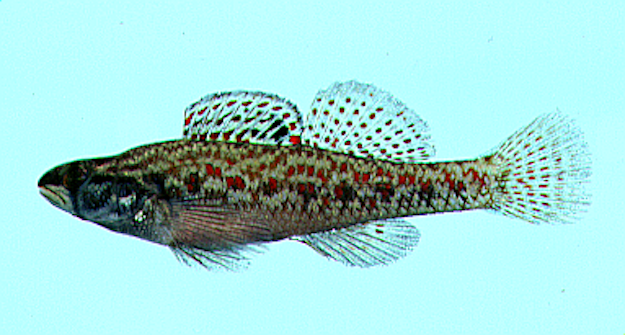
Visual survey method – surveying the abundance of animals, especially aquatic species, is notoriously difficult. Accurate abundance estimates are nonetheless needed to effectively manage species for harvest or for assessing their ecological and environmental health. The most common method used to collect small stream fishes is a small-meshed seine net. Indeed, another study of Okaloosa Darters conducted by biologist Steve Bortone used seines to quantify abundance in sites that were affected by treated sewer effluent and nearby control streams. This study using seines began prior to our research, ran concurrently for a few years, and was conducted at some of the same locations. We were concerned when comparing seine and visual data collected over the same time period and at the same locations because the two methods yielded strikingly different results, indicating one (or possibly) both methods was not accurately estimating abundance of Okaloosa Darters. We then collaborated with Dr. Bortone and found that the visual survey method was much more accurate and precise than the seine method for estimating abundance, which makes sense given that seines are hindered by abundant root mats, snags, and other obstacles in streams. Importantly, seining yields much lower estimates of abundance of Okaloosa Darters than our visual survey method. The 1973 estimate of <2,000 individuals was likely much lower than actual abundance.
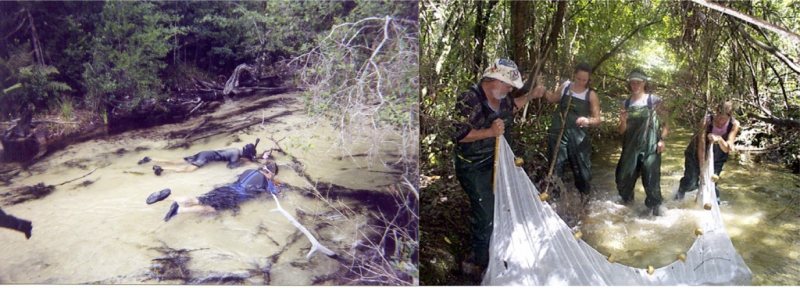
Long-term monitoring – the “meat and potatoes” part of our research has been quantifying the abundance of Okaloosa Darters at a set of 21 long-term monitoring sites each year since 1995. Monitoring data are useful for assesing population trends, detecting disturbances, and informing management and conservation decisions. For example, monitoring data colleced in this study were used to inform the decision to downlist Okaloosa Darters in 2011 and more recently to propose delisting in 2021.
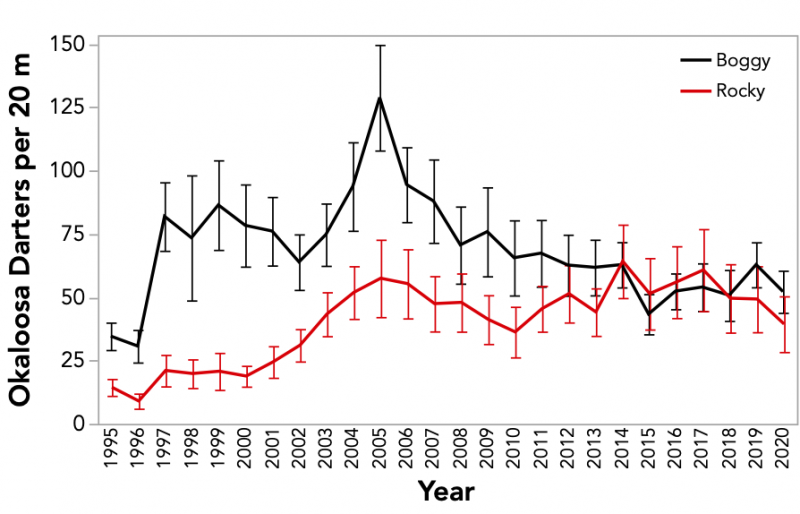
Erosion control – the landscape surrounding Okaloosa Darter streams is dominated by sandy subrate interspersed with deposits of clay, which is mined and used to stabilize a network of sandy roads across Eglin AFB. One of the major threats to Okaloosa Darters was erosion of sand from poorly managed clay borrow pits and road surfaces, which resulted in preferred habitats being smothered with eroded sand. A top priority of Jackson Guard Natural Resources Office was to restore these clay pits, plant native vegetation to stabilize sediments, and reduce the number of stream crossing by closing roads. They achieved a substantial reduction in sediment loading into streams, which was correlated with the early increases in abudance of Okaloosa Darters observed during long-term monitoring.
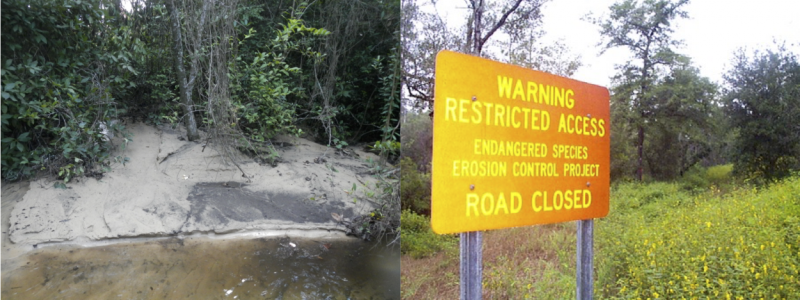
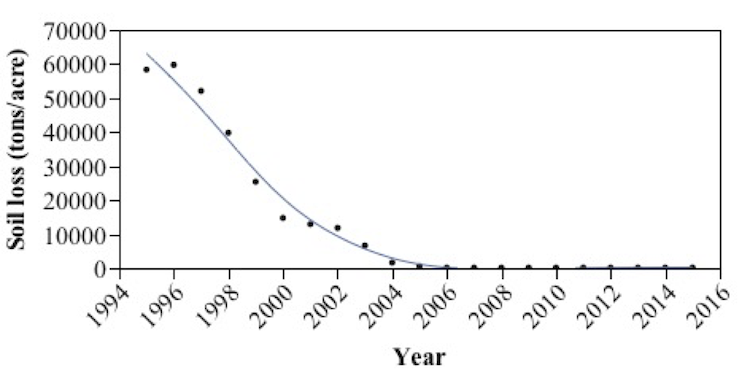
Habitat restoration – impoundment of streams results in reduced flow, accumulation of flocculent organic substrate, increased abundance of predatory fishes, and more variable thermal regimes. Okaloosa Darters are intolerant of these conditions and are rapidly extirpated following impoundment. Large, permanent impoundments on Anderson Branch, Mill Creek, and Toms Creek were removed or reduced in size, stream channels were restored, riparian and vegetation was planted. Monitoring revealed that Okaloosa Darters quickly recolonize restored stream reaches. Restoration increased total amount of habitat available and thereby increased total population size of Okaloosa Darters.

Population genetics – does it matter if Okaloosa Darters in one of the six streams they inhabit are extirpated? We addressed this question by collaborating with Jim Austin, a molecular systematist at the University of Florida. Representative individuals were collected from throughout the geographic range of Okaloosa Darters and portions of their genomes were sequenced and compared. What we found is that the three main drainages - Toms, Turkey, and Rocky creeks - supported genetically distinct populations. Okaloosa Darters from the three smaller streams had admixtures of genes from Rocky and Turkey creeks, but were nonetheless distinct. This suggests that resource managers should strive to at least manage and protect the populations in the three large streams. Also, any future translocations should be done using fish from genetically similar source locations.
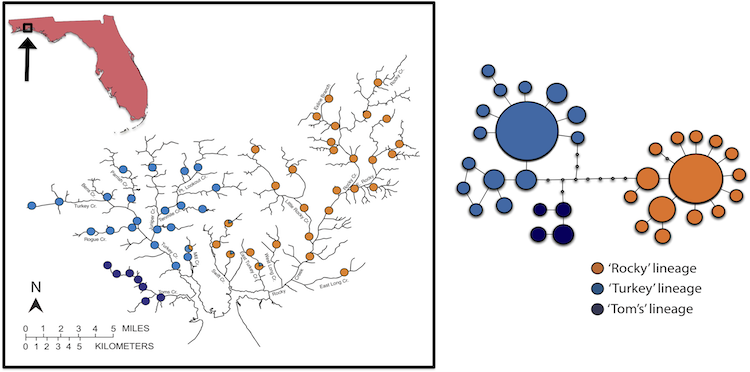
Movement and longevity – results of our population genetic studies indicated that there was relatively little movement among the three larger drainages occupied by Okaloosa Darters. Additional unpublished data and personal observations led us to hypothesize that Okaloosa Darters are relatively sedentary compared to many other types of fishes. We conducted mark-recapture studies to test this hypothesis. We first compared how well fin clips and highly visible injectable elastomer dyes were detected when marked fish were recaptured. We found that fin clips quickly regenerated and made it difficult to identify marked fish. We next recruited an undergraduate with very steady hands - young Dan Holt - to inject tiny fish with elastomer dyes. Marks were retained quite well and did not appear to affect fish in any noticeable ways. We proceeded to mark several hundred individuals at six separate locations with different colored dyes on either the right or left dorsum depending on the side that the fish was initially collected. What we discovered is that Okaloosa Darters are indeed relatively sedendary, only move short distances, and do not move from one side of the stream to the other unless there is a submerged tree or similar form of habitat corridor. We also learned that some darters live much longer than the two year average that earlier researchers proposed. Indeed, one individual was recaptured in the same 20 m reach seven years in a row, indicating that Okaloosa Darters can live at least this long in the wild.
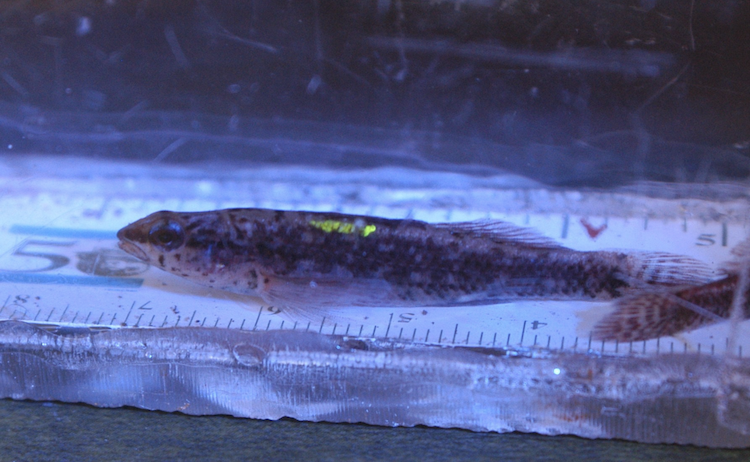
Canopy removal experiment – the most recent question that we've been addressing is how does increasingly dense canopy growth above streams affect Okaloosa Darters. The always insightful Noel Burkhead observed that more Okaloosa Darters appeared to be present in stream reaches that had relatively open canopies, primarily due to intensive and extensive fires in the riparian zone and surrounding uplands. We tested this hypothesis by using our visual method to detect more Okaloosa Darters in three naturally open opens than in three naturally closed sites. Of course, other factors could have been responsible for the differences in abundance that we observed. We therefore conducted an experiment on Turkey Creek in which the canopy was removed from overhead in four stream reaches (open canopy treatment) and left intact in four nearby stream reaches (closed canopy treatment). We found that Okaloosa Darters rapidly moved into the newly opened stream reaches. We are currently assessing the relative importance of increased primary and secondary production to this increase in abundance.
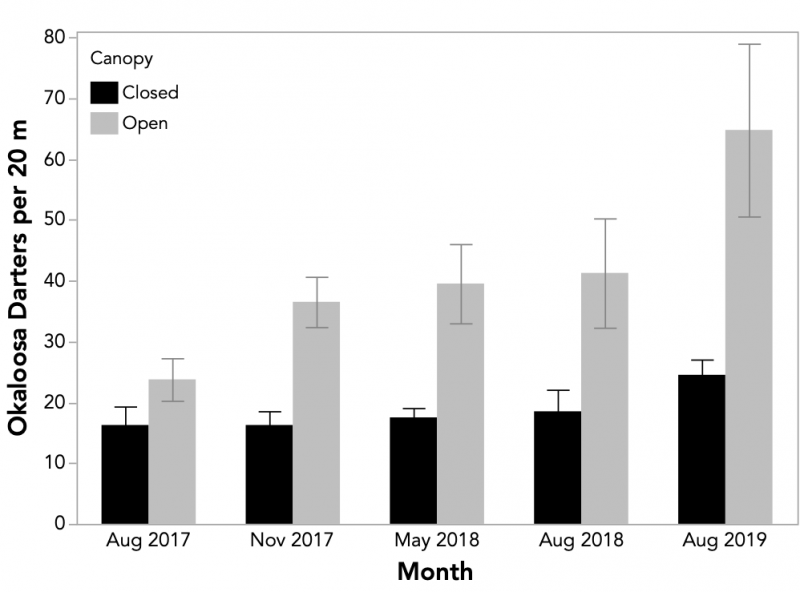
Remaining challenges - at least two threats remain to the long-term viability of Okaloosa Darters. The first threat is habitat loss and alteration associated with residential development in the lower reaches of streams that are found outside of Eglin AFB. These threats can be mitigated to a degree by enforcing exising restrictions on impounding or diverting flow from these streams. A more vexing aspect of residential development is that much of the sewerage generated in this area is treated and then sprayed on uplands that drain into streams containing Okaloosa Darters. We have found that abundance of Okaloosa Darters is significantly reduced in these streams relative to nearby control streams. Experiments should be conducted after de-listing to identify the factors (e.g., greatly increased conductivity) that are causing these reductions in abundance.
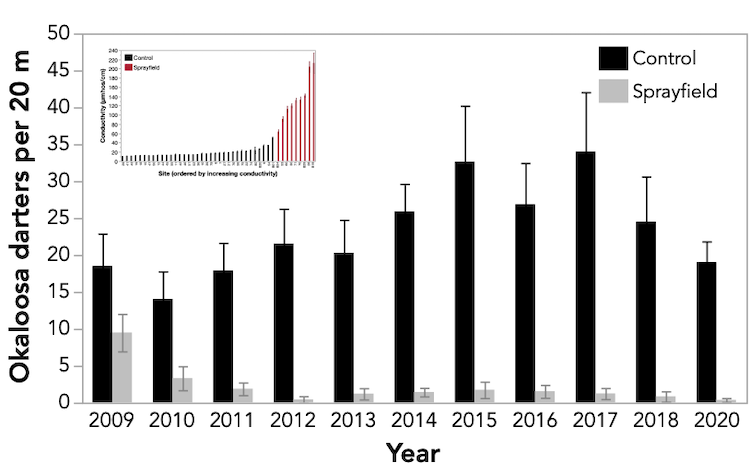
A second threat that remains is the impoundment of Swift Creek above College Boulevard. Okaloosa Darters are extirpated from stream sections once they are impounded by beaver dams or human structures such as undersized culverts and dams. Not only is a significant stretch of Swift Creek above the dam affected, but Okaloosa Darters are also absent from Swift Creek below the dam due to a profoundly altered thermal regime (i.e., greater temperature extremes and variability). Although costly, this issue could easily be mitigated by removing the dam, restoring the channel, and planting the riparion zone. Similar to the restoration on Anderson Branch, a somewhat smaller recreational pond can be retained adjacent to the new channel. A win win situation for ecosystem management and public recreation.
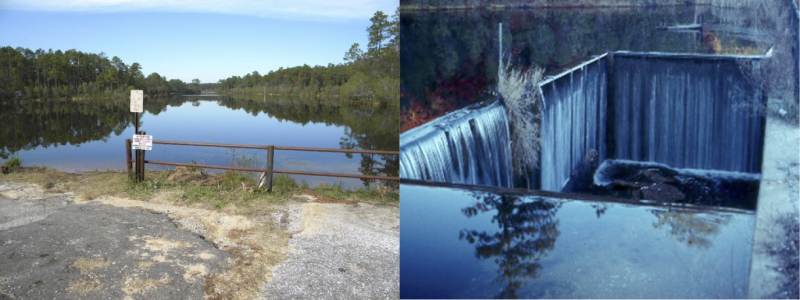
Publications from this project (asterisks denote student co-authors)
- Dorazio, R., H. L. Jelks, and F. Jordan. 2005. Improving removal-based estimates of abundance by sampling a population of spatially distinct subpopulations. Biometrics 61:1093-1101.
- Dorazio, R. M., B. Mukherjee, L. Zhang, M. Ghosh, H. L. Jelks, and F. Jordan. 2008. Modeling unobserved sources of heterogeneity in animal abundance using a Dirichlet process prior. Biometrics 64:635-644.
- Jordan, F., H. L. Jelks, S. Bortone, and R. M. Dorazio. 2008. Comparison of visual survey and seining methods for a benthic stream fish. Environmental Biology of Fishes 81:313-319.
- Champagne*, C., J.D. Austin, H. L. Jelks, and F. Jordan. 2008. Effects of fin clipping on survival and position-holding behavior of Brown Darters, Etheostoma edwini. Copeia 2008:916-919.
- Austin, J. D., H.L. Jelks, W. Tate, A. R. Johnson, and F. Jordan. 2011. Population genetic structure and conservation genetics of endangered Okaloosa darters (Etheostoma okaloosae). Conservation Genetics 12:981-989.
- Jelks, H., B. Tate, and F. Jordan. 2011. Weapons testing and endangered fish coexist in Florida. USFWS Endangered Species Bulletin 36:46-47.
- Hughey*, M.C., D.C. Heins, H.L. Jelks B.A. Ory*, and F. Jordan. 2012. Variation in reproductive life history traits between two populations of Blackbanded Darters (Percina nigrofasciata). Copeia 2012:714–721.
- Holt*, D.E., H.L. Jelks, and F. Jordan. 2013. Movement and longevity of imperiled Okaloosa Darters (Etheostoma okaloosae). Copeia 2013:653-659.
- Reeves*, D.B, W.B. Tate, H.L. Jelks, and F. Jordan. 2016. Response of imperiled Okaloosa darters to stream restoration. North American Journal of Fisheries Management 36:1375–1385.
